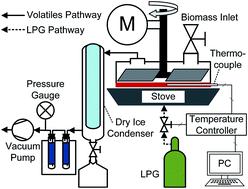Our official English website, www.x-mol.net, welcomes your
feedback! (Note: you will need to create a separate account there.)
Bio-oils from vacuum ablative pyrolysis of torrefied tobacco residues
RSC Advances ( IF 3.9 ) Pub Date : 2020-9-22 , DOI: 10.1039/d0ra06014c Nattawut Khuenkaeo 1 , Blake MacQueen 2 , Thossaporn Onsree 1 , Sangu Daiya 3 , Nakorn Tippayawong 1 , Jochen Lauterbach 2, 4
RSC Advances ( IF 3.9 ) Pub Date : 2020-9-22 , DOI: 10.1039/d0ra06014c Nattawut Khuenkaeo 1 , Blake MacQueen 2 , Thossaporn Onsree 1 , Sangu Daiya 3 , Nakorn Tippayawong 1 , Jochen Lauterbach 2, 4
Affiliation

|
Fast pyrolysis, in combination with torrefaction pretreatment, was used to convert tobacco residues to value-added bio-fuels and chemicals. Tobacco plant residues were torrefied at 220, 260, and 300 °C, before being pyrolyzed at 450, 500, 550, and 600 °C in a rotating blade ablative reactor under vacuum conditions to test the effects on product yields. With torrefaction, tobacco residues thermally decomposed 20–25% w/w at low temperatures. Torrefaction and pyrolysis temperatures were found to markedly affect pyrolytic product yields of bio-chars and bio-oils, while having no effect on gas-phase products. Bio-oil yields exhibited a direct relation with pyrolysis temperature and an inverse relation with torrefaction temperature. Bio-oils produced were separated into light and heavy oils and analyzed by GC-MS, and 1H and 13C NMR. Nicotine was found to be the main compound in the light and heavy oils along with several phenols and cresols in the heavy oil.
中文翻译:

烘焙烟草残留物的真空烧蚀热解生物油
快速热解与烘焙预处理相结合,用于将烟草残留物转化为增值的生物燃料和化学品。烟草植物残渣在 220、260 和 300 °C 下烘烤,然后在真空条件下在旋转叶片烧蚀反应器中在 450、500、550 和 600 °C 下热解,以测试对产品产量的影响。通过烘焙,烟草残留物在低温下热分解 20–25% w/w。发现烘焙和热解温度显着影响生物炭和生物油的热解产物产量,而对气相产物没有影响。生物油产量与热解温度呈正相关,与烘焙温度呈反比关系。将生产的生物油分离为轻油和重油,并通过 GC-MS 进行分析,1H和13 C NMR。尼古丁被发现是轻油和重油中的主要化合物以及重油中的几种酚和甲酚。
更新日期:2020-09-22
中文翻译:

烘焙烟草残留物的真空烧蚀热解生物油
快速热解与烘焙预处理相结合,用于将烟草残留物转化为增值的生物燃料和化学品。烟草植物残渣在 220、260 和 300 °C 下烘烤,然后在真空条件下在旋转叶片烧蚀反应器中在 450、500、550 和 600 °C 下热解,以测试对产品产量的影响。通过烘焙,烟草残留物在低温下热分解 20–25% w/w。发现烘焙和热解温度显着影响生物炭和生物油的热解产物产量,而对气相产物没有影响。生物油产量与热解温度呈正相关,与烘焙温度呈反比关系。将生产的生物油分离为轻油和重油,并通过 GC-MS 进行分析,1H和13 C NMR。尼古丁被发现是轻油和重油中的主要化合物以及重油中的几种酚和甲酚。










































 京公网安备 11010802027423号
京公网安备 11010802027423号